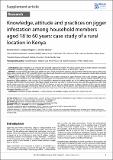| dc.contributor.author | Kimani, Bernard | |
| dc.contributor.author | Nyagero, Josephat | |
| dc.contributor.author | Ikamari, Lawrence | |
| dc.date.accessioned | 2021-08-16T22:01:53Z | |
| dc.date.available | 2021-08-16T22:01:53Z | |
| dc.date.issued | 12/25/2012 | |
| dc.identifier.citation | Bernard Kimani, Josephat Nyagero, Lawrence Ikamari. Knowledge, attitude and practices on jigger infestation among household members aged 18 to 60 years: case study of a rural location in Kenya. Pan Afr Med J. 2012;13(Supp 1):7 | en_US |
| dc.identifier.issn | 1937-8688 | |
| dc.identifier.uri | http://dspace.amref.org/handle/123456789/58 | |
| dc.description | This article is published as part of the supplement “AMREF´s evidence in advancing the health of women and children”
Supplement sponsored by AMREF - African Medical and Research Foundation
© Bernard Kimani et al. The Pan African Medical Journal - ISSN 1937-8688. This is an Open Access article distributed under the terms of the Creative Commons Attribution License (http://creativecommons.org/licenses/by/2.0), which permits unrestricted use, distribution, and reproduction in any medium, provided the original work
is properly cited. | en_US |
| dc.description.abstract | Introduction: Jigger infestation is an important but neglected public health problem. The study assessed the knowledge, attitude and practices
of household members on jigger infestation, practices and control within Murang’a district, a rural location in Kenya.
Methods: A cross-sectional descriptive study design was used. Structured interview schedules and observation checklist were used to collect quantitative data. A sample size of 271 household members was interviewed. Descriptive and inferential statistics were analyzed and odds ratios computed
at 95% confidence interval to determine variables association.
Results: On knowledge, 70.1% acknowledged poor hygiene and sanitation contributes to jigger infestation while 16.6% identified jigger flea as
the cause of jigger infestation. Over half (53.9%) reported jiggers are transmissible from person to person. Majority (94.8%) identified signs and
symptoms of jigger infestation. Over a quarter (23.6%) reported an infested household member and 18.8% infested persons were confirmed during
the study. Many (59.8%) held the opinion that, jigger infested persons are lazy, 26.2% reported they are poor and 12% reported they either have
specific blood or are from certain families. Below half (48.7%) believed in myths and misconceptions on jiggers. Majority (90.8%) reported needles/
pins were the mostly used jigger removal items followed by thorns 38.7%. About two thirds (62.0%) were not aware of communal jigger prevention
and control activities. The Chi-square results showed that, the village, type of house floor and compound maintenance were significantly associated
with jigger infestation (p<0.05).
Conclusion: Knowledge on jigger infestation is high but this has not translated to jigger prevention and control in the area. | en_US |
| dc.description.sponsorship | Central Kenya Dry Areas Small Holders Project, and Ministry of Public Health and Sanitation | en_US |
| dc.language.iso | en | en_US |
| dc.publisher | Pan African Medical Journal | en_US |
| dc.subject | knowledge attitude and practices | |
| dc.subject | Household | |
| dc.subject | Jigger infestation | en_US |
| dc.title | Knowledge, Attitude and Practices on Jigger Infestation Among Household Members Aged 18 to 60 Years | en_US |
| dc.title.alternative | Case study of a rural location in Kenya | en_US |
| dc.type | Article, Journal | en_US |

